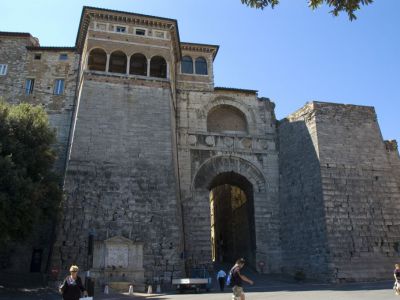
Arco Etrusco o d'Augusto (Etruscan Arch), Perugia
Built sometime in the third century BC, the Etruscan Arch was one of seven gates granting access to the city of Perugia through its massive walls. Ensconced between two great trapezoidal turrets or donjons, this gate is the best preserved of all the seven gates of the city.
The gate has changed its name on several occasions over time. It has been Porta Terzia, Porta Borca, Arco Trionfale, Porta Vecchia and Porta Pulchra. Besides the two turrets it has a facade with an arch. Above the arch on the left is a Renaissance loggia. At the foot of the same tower is a 17th century fountain.
The arch is also called Arco Augusto for the Emperor Augustus, also known as Octavian. The words "Augusta Perusia" were inscribed on the arch two centuries after it was built to mark the conquest of the city by the Emperor. In the year 40 BC civil war had broken out between Augustus and his former ally, Mark Antony.
Antony's brother, Lucius, had holed up in Perugia with his army and Augustus laid siege to the city. Eventually Lucius surrendered and Augustus sacked, looted and burned the city. But he spared the temples of Vulcan and Juno, so it wasn't all bad. Augustus repented a bit. The citizens could rebuild the city with the name "Augusta Perusia."
In the period 251 to 253 AD the Emperor Gallus honored the city, awarding it the status of Colony. Gallus' antecedents were Perugian. Gallus himself died in yet one more civil war two years later.
Going through the arch, follow Ulisse Rocchi Street and arrive at Corso Vannucci, really the main street of Perugia to this day.
The gate has changed its name on several occasions over time. It has been Porta Terzia, Porta Borca, Arco Trionfale, Porta Vecchia and Porta Pulchra. Besides the two turrets it has a facade with an arch. Above the arch on the left is a Renaissance loggia. At the foot of the same tower is a 17th century fountain.
The arch is also called Arco Augusto for the Emperor Augustus, also known as Octavian. The words "Augusta Perusia" were inscribed on the arch two centuries after it was built to mark the conquest of the city by the Emperor. In the year 40 BC civil war had broken out between Augustus and his former ally, Mark Antony.
Antony's brother, Lucius, had holed up in Perugia with his army and Augustus laid siege to the city. Eventually Lucius surrendered and Augustus sacked, looted and burned the city. But he spared the temples of Vulcan and Juno, so it wasn't all bad. Augustus repented a bit. The citizens could rebuild the city with the name "Augusta Perusia."
In the period 251 to 253 AD the Emperor Gallus honored the city, awarding it the status of Colony. Gallus' antecedents were Perugian. Gallus himself died in yet one more civil war two years later.
Going through the arch, follow Ulisse Rocchi Street and arrive at Corso Vannucci, really the main street of Perugia to this day.
Want to visit this sight? Check out these Self-Guided Walking Tours in Perugia. Alternatively, you can download the mobile app "GPSmyCity: Walks in 1K+ Cities" from Apple App Store or Google Play Store. The app turns your mobile device to a personal tour guide and it works offline, so no data plan is needed when traveling abroad.
Arco Etrusco o d'Augusto (Etruscan Arch) on Map






Sight Name: Arco Etrusco o d'Augusto (Etruscan Arch)
Sight Location: Perugia, Italy (See walking tours in Perugia)
Sight Type: Attraction/Landmark
Guide(s) Containing This Sight:
Sight Location: Perugia, Italy (See walking tours in Perugia)
Sight Type: Attraction/Landmark
Guide(s) Containing This Sight:
Walking Tours in Perugia, Italy
Create Your Own Walk in Perugia
Creating your own self-guided walk in Perugia is easy and fun. Choose the city attractions that you want to see and a walk route map will be created just for you. You can even set your hotel as the start point of the walk.
Perugino and Renaissance Art Walk
Perugia today is a well-known cultural and artistic center in Italy that regularly plays host to a multitude of annual festivals and events. The most glorious period in the history of the city, from an artistic standpoint, lasted from the 13th to the 16th centuries.
Perugia’s most celebrated artist, Pietro Vannucci (1450–1523), better known as “il Perugino”, nicknamed so after his... view more
Tour Duration: 1 Hour(s)
Travel Distance: 2.3 Km or 1.4 Miles
Perugia’s most celebrated artist, Pietro Vannucci (1450–1523), better known as “il Perugino”, nicknamed so after his... view more
Tour Duration: 1 Hour(s)
Travel Distance: 2.3 Km or 1.4 Miles
Perugia Introduction Walking Tour
Perugia was one of the twelve foremost cities of the Etruscan Federation. It was mentioned by Quintus Fabius Pictor, a Roman historian. He tells of a military expedition of Fabius Maximus Rullianus against the Etruscan League and Perugia in 309 BC.
By 216 BC, Perugia had seen the light and allied itself with Rome in the Second Punic War against Carthage. Things went swimmingly until 41 BC.... view more
Tour Duration: 2 Hour(s)
Travel Distance: 2.1 Km or 1.3 Miles
By 216 BC, Perugia had seen the light and allied itself with Rome in the Second Punic War against Carthage. Things went swimmingly until 41 BC.... view more
Tour Duration: 2 Hour(s)
Travel Distance: 2.1 Km or 1.3 Miles


